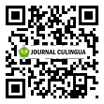MEMAAFKAN (TO FORGIVE) IN THE NOVEL HUJAN DAN TEDUH
DOI:
https://doi.org/10.37301/culingua.v3i1.101Keywords:
positive emotions, negative emotions, memaafkan (to forgive)Abstract
The main character of the novel Hujan dan Teduh named Bintang reflects his always forgiving attitude. The concept of forgiveness is manifested through the words maaf (forgiveness or forgive), memaafkan (to forgive), maafin (forgive in colloquial Indonesian), and dimaafkan (to be forgiven) and exists in many cultures, both in Indonesia and elsewhere. The purpose of this study was to determine the kind of emotion or state of mind the word maaf is included is based on the five classes of emotion from Santangelo (1995) and to construct the component parameter of meaning from that word based on its class using Nida's theory (1975). The results of this study will reveal that the concept of forgiveness in Indonesian culture can contain various emotions. The significance of this research is to enrich the repertoire of research in the field of emotion especially associated with the concept of forgiveness for the people of Indonesia. This study focuses on the analysis of the state of mind and thoughts expressed in the novel Hujan dan Teduh. The theory used to perform the analysis is Santangelo's emotional theory. The data is in the form of the word maaf (forgiveness or forgive), memaafkan (to forgive), maafin (forgive in colloquial Indonesian), and dimaafkan (to be forgiven). To obtain the expression of the state of mind which is reflected in the four data words, the classification of data into the types of emotions based on the context that accompanies it is performed. This research uses the literature method and the results of the analysis are descriptive qualitative.
References
Anthony, L. (2019). AntConc. Tokyo, Japan: Waseda University. Retrieved from http://www.antlab.sci.waseda.ac.jp/
Ataei, S. (2019). Exploring the Emotional Language in the Twilight Novel as a Literary Discourse?: An Appraisal Theory Analysis. Purdue Linguistics, Literature, and Second Language Studies Conference, 2, 1–31. Retrieved from https://docs.lib.purdue.edu/plcc
Dewatra, W. (2011). Hujan dan Teduh. Jakarta: Gagas Media.
Ekman, P. (1992). An argument for basic emotions. Cognition and Emotion, 6(3–4), 169–200. https://doi.org/10.1080/02699939208411068
Heider, K. G. (1991). Landscapes of Emotion: Mapping Three Cultures of Emotion in Indonesia. Cambridge: Cambridge University Press.
Izard, C. E. (1991). The Psychology of Emotions. New York: Plenum Press.
Kahn, J. H., Tobin, R. M., Massey, A. E., & Anderson, J. A. (2007). Measuring Emotional Expression with the Linguistic Inquiry and Word Count. The American Journal of Psychology, 120(2), 263. https://doi.org/10.2307/20445398
Kolyadko, S. V. (2019). Emotion and feeling as the concept of literary analysis of poetry. Proceedings of the National Academy of Sciences of Belarus, Humanitarian Series, 64(1), 93–102. https://doi.org/10.29235/2524-2369-2019-64-1-93-102
Nida, E. A. (1975). Componential Analysis of Meaning. Belgium: Mouton Publishers.
Santangelo, P. (1995). A Research on Emotions and States of Mind in Late Imperial China: Preliminary Results. In P. Sangelo (Ed.), Ming Qing Yanjiu (pp. 101–209). Napoli, Roma: Dipartimento di Studi Asiatici Istituto Universitario Orientale Napoli.
Santangelo, P. (2002). Description of the Research Project and Theoretical Problems. Loose print.
Starcke, B. F. (2010). Corpus Linguistics in Literary Analysis. In Studies in Corpus and Discourse. London: Continuum.
Tan, T. Y., & Santangelo, P. (2014). Passion, Romance, and Qing: The World of Emotions and States of Mind in Peony Pavilion. Leiden, Boston: Brill.
Wierzbicka, A. (1992). Defining Emotion Concepts. Cognitive Science, 16, 539–581.
Yavuz, M. C. (2020). Analyses of Character Emotions in Dramatic Works by Using EmoLex Unigrams. In Proceedings of the Seventh Italian Conference on Computational Linguistics CLiC-it 2020 (Vol. 2769, pp. 471–476). Accademia University Press. https://doi.org/10.4000/books.aaccademia.9004
Downloads
Published
Issue
Section
License
Copyright (c) 2022 Dewi Puspita, Izha, Hermina

This work is licensed under a Creative Commons Attribution 4.0 International License.









